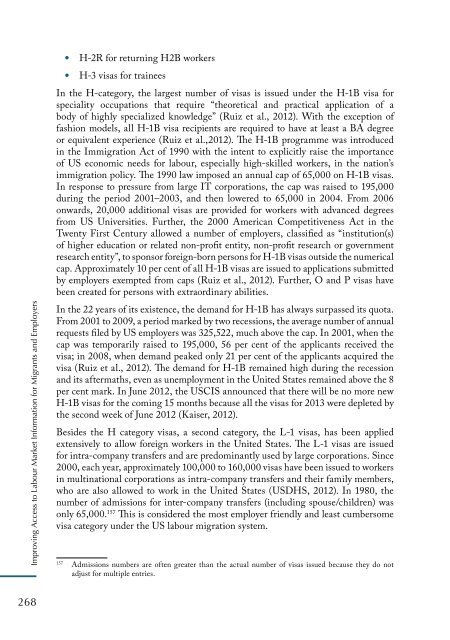International Organization for Migration (IOM)
International Organization for Migration (IOM)
International Organization for Migration (IOM)
Create successful ePaper yourself
Turn your PDF publications into a flip-book with our unique Google optimized e-Paper software.
Improving Access to Labour market In<strong>for</strong>mation <strong>for</strong> migrants and employers<br />
268<br />
• H-2R <strong>for</strong> returning H2B workers<br />
• H-3 visas <strong>for</strong> trainees<br />
In the H-category, the largest number of visas is issued under the H-1B visa <strong>for</strong><br />
speciality occupations that require “theoretical and practical application of a<br />
body of highly specialized knowledge” (Ruiz et al., 2012). With the exception of<br />
fashion models, all H-1B visa recipients are required to have at least a BA degree<br />
or equivalent experience (Ruiz et al.,2012). The H-1B programme was introduced<br />
in the Immigration Act of 1990 with the intent to explicitly raise the importance<br />
of US economic needs <strong>for</strong> labour, especially high-skilled workers, in the nation’s<br />
immigration policy. The 1990 law imposed an annual cap of 65,000 on H-1B visas.<br />
In response to pressure from large IT corporations, the cap was raised to 195,000<br />
during the period 2001–2003, and then lowered to 65,000 in 2004. From 2006<br />
onwards, 20,000 additional visas are provided <strong>for</strong> workers with advanced degrees<br />
from US Universities. Further, the 2000 American Competitiveness Act in the<br />
Twenty First Century allowed a number of employers, classified as “institution(s)<br />
of higher education or related non-profit entity, non-profit research or government<br />
research entity”, to sponsor <strong>for</strong>eign-born persons <strong>for</strong> H-1B visas outside the numerical<br />
cap. Approximately 10 per cent of all H-1B visas are issued to applications submitted<br />
by employers exempted from caps (Ruiz et al., 2012). Further, O and P visas have<br />
been created <strong>for</strong> persons with extraordinary abilities.<br />
In the 22 years of its existence, the demand <strong>for</strong> H-1B has always surpassed its quota.<br />
From 2001 to 2009, a period marked by two recessions, the average number of annual<br />
requests filed by US employers was 325,522, much above the cap. In 2001, when the<br />
cap was temporarily raised to 195,000, 56 per cent of the applicants received the<br />
visa; in 2008, when demand peaked only 21 per cent of the applicants acquired the<br />
visa (Ruiz et al., 2012). The demand <strong>for</strong> H-1B remained high during the recession<br />
and its aftermaths, even as unemployment in the United States remained above the 8<br />
per cent mark. In June 2012, the USCIS announced that there will be no more new<br />
H-1B visas <strong>for</strong> the coming 15 months because all the visas <strong>for</strong> 2013 were depleted by<br />
the second week of June 2012 (Kaiser, 2012).<br />
Besides the H category visas, a second category, the L-1 visas, has been applied<br />
extensively to allow <strong>for</strong>eign workers in the United States. The L-1 visas are issued<br />
<strong>for</strong> intra-company transfers and are predominantly used by large corporations. Since<br />
2000, each year, approximately 100,000 to 160,000 visas have been issued to workers<br />
in multinational corporations as intra-company transfers and their family members,<br />
who are also allowed to work in the United States (USDHS, 2012). In 1980, the<br />
number of admissions <strong>for</strong> inter-company transfers (including spouse/children) was<br />
only 65,000. 157 This is considered the most employer friendly and least cumbersome<br />
visa category under the US labour migration system.<br />
157 Admissions numbers are often greater than the actual number of visas issued because they do not<br />
adjust <strong>for</strong> multiple entries.


